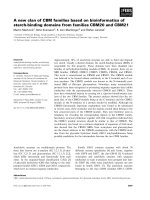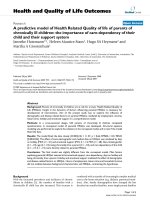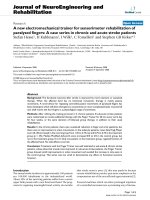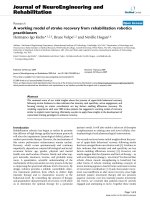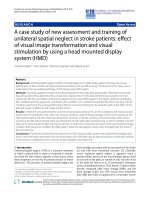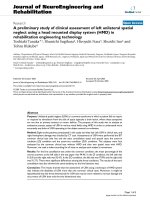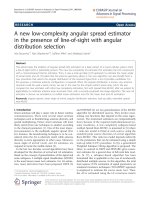Báo cáo hóa học: "A NEW SYSTEM OF GENERALIZED NONLINEAR RELAXED COCOERCIVE VARIATIONAL INEQUALITIES" pptx
Bạn đang xem bản rút gọn của tài liệu. Xem và tải ngay bản đầy đủ của tài liệu tại đây (556.99 KB, 14 trang )
A NEW SYSTEM OF GENERALIZED NONLINEAR RELAXED
COCOERCIVE VARIATIONAL INEQUALITIES
KE DING, WEN-YONG YAN, AND NAN-JING HUANG
Received 21 November 2004; Revised 13 April 2005; Accepted 28 June 2005
We introduce and study a new system of generalized nonlinear relaxed cocoercive in-
equality problems and construct an iterative algorithm for approximating the solutions
of the system of generalized relaxed cocoercive variational inequalities in Hilbert spaces.
We prove the existence of the solutions for the system of generalized relaxed cocoercive
variational inequality problems and the convergence of iterative sequences generated by
thealgorithm.Wealsostudytheconvergenceandstabilityofanewperturbediterative
algorithm for approximating the solution.
Copyright © 2006 Ke Ding et al. This is an open access article distributed under the Cre-
ative Commons Att ribution License, which permits unrestricted use, distribution, and
reproduction in any medium, provided the original work is properly cited.
1. Introduction
Variational inequality problems have various applications in mechanics and physics, opti-
mization and control, linear and nonlinear programming, economics and finance, trans-
portation equilibrium and eng ineering science, and so forth. Consequently considerable
attention has been devoted to the study of the theory and efficient numerical methods
for variational inequality problems (see, e.g., [2–17] and the references therein). In [15],
Verma introduced a new system of nonlinear strongly monotone variational inequalities
and studied the approximate of this system based on the projection method, and in [16],
Verma discussed the approximate solvability of a system of nonlinear relaxed cocoercive
variational inequalities in Hilbert spaces. Recently, Kim and Kim [14] introduced and
studied a system of nonlinear mixed variational inequalities in Hilbert spaces, and ob-
tained some approximate solvability results. In the recent paper [6], Cho et al. introduced
and studied a new system of nonlinear variational inequalities in Hilbert spaces. They
proved some existence and uniqueness theorems of solutions for the system of nonlinear
variational inequalities. They also constructed an iterative algorithm for approximating
the solution of the system of nonlinear variational inequalities. Some related works, we
refer to [2, 3, 5, 7–10, 12, 13]. Motivated and inspired by these works, in this paper, we
introduce and study a new system of generalized nonlinear relaxed cocoercive variational
Hindawi Publishing Corporation
Journal of Inequalities and Applications
Volume 2006, Article ID 40591, Pages 1–14
DOI 10.1155/JIA/2006/40591
2 Nonlinear relaxed cocoercive variational inequalities
inequality problems and construct an iterative algorithm for approximating the solutions
of the system of generalized relaxed cocoercive variational inequalities in Hilbert spaces.
We prove the existence of the solutions for the system of generalized relaxed cocoercive
variational inequality problems and the convergence of iterative sequences generated by
thealgorithm.Wealsostudytheconvergenceandstabilityofanewperturbediterative
algorithm for approximating the solution. The results presented in this paper improve
and extend the previously known results in this area.
2. Preliminaries
Let H be a Hilbert space endowed with a norm
·and inner product (·,·), respectively.
Let CB(H) be the family of all nonempty subsets of H and K
1
, K
2
be two convex and
closed subsets of H.Letg
1
, g
2
, m
1
, m
2
: H → H and F, G : H × H → H be mappings. We
consider the following system of generalized nonlinear variational inequality problems:
find x, y
∈ H such that g
i
(x) ∈ K
i
(x)fori = 1, 2, and
F(x, y),z − g
1
(x)
≥
0, ∀z ∈ K
1
(x),
G(x, y),z − g
2
(y)
≥
0, ∀z ∈ K
2
(y),
(2.1)
where K
i
(x) = m
i
(x)+K
i
for i = 1, 2.
When K
1
and K
2
are both convex cones of H, it is easy to see that problem (2.1)is
equivalent to the following system of generalized nonlinear co-complementarity prob-
lems: find x, y
∈ H such that g
i
(x) ∈ K
i
(x)fori = 1, 2, and
F(x, y)
∈
K
1
(x) − g
1
(x)
∗
,
G(x, y)
∈
K
2
(y) − g
2
(y)
∗
,
(2.2)
where K
i
(x) = m
i
(x)+K
i
and (K
i
(x) − g
i
(x))
∗
is the dual of K
i
(x) − g
i
(x)fori = 1, 2, that
is,
K
i
(x) − g
i
(x)
∗
=
u ∈ H | (u,v) ≥ 0, ∀v ∈ K
i
(x) − g
i
(x)
. (2.3)
Some examples of problems (2.1)and(2.2)areasfollows.
(I) If G
= 0andF(x, y) = Tx +Ax for all x, y ∈ X,whereT, A : H → H are two map-
pings, then problem (2.2) reduces to finding x
∈ H such that
Tx+ Ax ∈
K
1
(x) − g
1
(x)
∗
, (2.4)
which is called the generalized complementarity problem. The problem (2.4)wasex-
tended and studied by Jou and Yao [11] in Hilbert spaces, and by Chen et al. [5]inthe
setting of Banach spaces.
(II) Let T : H
× H → H be a mapping. If F(x, y) = ρT(y,x)+x − y, G(x, y) = ηT(x, y)
+ y
− x for all x, y ∈ H, m
1
= m
2
= 0, K
1
= K
2
= K,andg
1
= g
2
= I,whereI is an identity
Ke Ding et al. 3
mapping and ρ>0, η>0, then problem (2.1) reduces to finding x, y
∈ K such that
ρT(y, x)+x − y,z − x
≥
0, ∀z ∈ K,
ηT(x, y)+y − x,z − y
≥
0, ∀z ∈ K,
(2.5)
which is called the system of nonlinear variational inequality problems considered by
Ver m a [ 16]. The special case of problem (2.5) was studied by Verma [15]. The problem
(2.5) was extended and studied by Agarwal et al. [1], Kim and Kim [14], and Cho et al.
[6].
(III) If m
1
= m
2
= 0, and g
1
= g
2
= I,thenproblem(2.1) reduces to finding x ∈ K
1
and
y
∈ K
2
such that
F(x, y),z − x
≥
0, ∀z ∈ K
1
,
G(x, y),z − y
≥
0, ∀z ∈ K
2
,
(2.6)
which is just the problem considered in [12]withF, G being single-valued mappings.
Definit ion 2.1. AmappingN : H
× H → H is said to be
(i) α-strongly monotone with respect to first argument if there exists some α>0such
that
N(x,·) − N(y,·),x − y
≥
αx − y
2
, ∀(x, y) ∈ H × H; (2.7)
(ii) ξ-Lipschitz continuous with respect to the first argument, if there exists a constant
ξ>0suchthat
N(x,·) − N(y,·)
≤
ξ
x − y
, ∀(x, y) ∈ H × H. (2.8)
Similarly, we can define the strong monotonicity and Lipschitzian continuity with re-
spect to the second argument of N.
Definit ion 2.2. AMappingN : H
× H → H is said to be relaxed (a,b)-cocoercive with
respect to the first argument if there exists constants a>0andb>0suchthat
N(x,·) − N(y,·),x − y
≥
(−a)x − y
2
+ bx − y
2
, ∀(x, y) ∈ H × H. (2.9)
If a
= 0, then N is b-strongly monotone. Similarly, we can define the relaxed (a,b)-co-
coercivity with respect to the second argument of N.
Lemma 2.3 [4]. If K
⊂ H is a closed convex subset and z ∈ H is a given point, then there
exists x
∈ K such that
(x
− z, y − x) ≥ 0, ∀y ∈ K (2.10)
if and only if x
= P
K
z,whereP
K
is the projection of H onto K.
Lemma 2.4 [4]. The projection P
K
is nonexpansive, that is,
P
K
u − P
K
v
≤
u − v, ∀u,v ∈ H. (2.11)
4 Nonlinear relaxed cocoercive variational inequalities
Lemma 2.5 [18]. Let
{K
n
} beasequenceofclosedconvexsubsetsofH such that H(K
n
,K) →
0 as n →∞,whereH(·,·) is the Hausdorff metric, that is, for any A,B ∈ CB(H),
H(A,B)
= max
sup
a∈A
inf
b∈B
a − b,sup
b∈B
inf
a∈A
a − b
. (2.12)
Then
P
K
n
v − P
K
v
−→
0(n −→ ∞ ), ∀v ∈ H. (2.13)
Lemma 2.6 [4]. If K(u)
= m(u)+K for all u ∈ H, then
P
K(u)
v = m(u)+P
K
v − m(u)
. (2.14)
From Lemmas 2.3 and 2.6, we have the following lemma.
Lemma 2.7. If K
1
,K
2
⊂ H are t wo closed convex cones, and K
i
(·) = m(·)+K
i
(i = 1,2),
then x, y
∈ H solve problem (2.1)ifandonlyifx, y ∈ H such that
x
= x − g
1
(x)+m
1
(x)+P
K
1
g
1
(x) − ρF(x, y) − m
1
(x)
,
y
= y − g
2
(y)+m
2
(y)+P
K
2
g
2
(y) − ρG(x, y) − m
2
(y)
,
(2.15)
where ρ>0 is a constant.
Lemma 2.8 [17]. Let
{μ
n
} be a real seque nce of nonnegative numbers and {ν
n
} beareal
sequence of numbers in [0,1] with
∞
n=0
ν
n
=∞. If there exists a constant n
1
such that
μ
n+1
≤
1 − ν
n
μ
n
+ ν
n
δ
n
, ∀n ≥ n
1
, (2.16)
where δ
n
≥ 0 for all n ≥ 0,andδ
n
→ 0 (n →∞), then lim
n→∞
μ
n
= 0.
3. Existence and convergence
In this section, we construct an iterative algorithm to approximate the solution of prob-
lem (2.1) and study the convergence of the sequence generated by the algorithm.
Algorithm 3.1. For any given x
0
, y
0
∈ H,wecompute
x
n+1
= x
n
− g
1
x
n
+ m
1
x
n
+ P
K
1
g
1
x
n
−
ρF
x
n
, y
n
−
m
1
x
n
,
y
n+1
= y
n
− g
2
y
n
+ m
2
y
n
+ P
K
2
g
2
y
n
−
ρG
x
n
, y
n
−
m
2
y
n
.
(3.1)
Theorem 3.2. Let g
i
: H → H be η
i
-strongly m onotone and ζ
i
-Lipschitz continuous and
m
i
: H → H be γ
i
-Lipschitz continuous (i = 1,2). Let F : H × H → H be l
1
, l
2
-Lipschitz con-
tinuous with respect to the first, second arguments, respectively, and relaxed (a,b)-cocoercive
with respect to the first argument. Let G : H
× H → H be n
1
, n
2
-Lipschitz continuous with
respect to the first, second arguments, respectively, and relaxed (c,d)-cocoercive with respect
Ke Ding et al. 5
to the second argument. If
2
1+ζ
2
1
− 2η
1
+2γ
1
+
1+ρ
2
l
2
1
+2ρal
2
1
− 2ρb + ρn
1
< 1,
2
1+ζ
2
2
− 2η
2
+2γ
2
+
1+ρ
2
n
2
2
+2ρcn
2
2
− 2ρd + ρl
2
< 1.
(3.2)
then there exist x
∗
, y
∗
∈ H, which solve problem (2.1). Moreover, the iterative sequences
{x
n
} and {y
n
} generated by Algorithm 3.1 converge to x
∗
and y
∗
,respectively.
Proof. From (3.1)andLemma 2.6,wehave
x
n+1
− x
n
=
x
n
− g
1
x
n
+ m
1
x
n
+ P
K
1
g
1
x
n
−
ρF
x
n
, y
n
−
m
1
x
n
−
x
n−1
− g
1
x
n−1
+ m
1
x
n−1
+ P
K
1
g
1
x
n−1
−
ρF
x
n−1
, y
n−1
−
m
1
x
n−1
≤
x
n
− x
n−1
−
g
1
x
n
−
g
1
x
n−1
+
m
1
x
n
−
m
1
x
n−1
+
P
K
1
g
1
x
n
−
ρF
x
n
, y
n
−
m
1
x
n
−
P
K
1
g
1
x
n−1
−
ρF
x
n−1
, y
n−1
−
m
1
(x
n−1
)
.
(3.3)
Since g
1
is ζ
1
-Lipschitz continuous and η
1
-strongly monotone,
x
n
− x
n−1
−
g
1
x
n
−
g
1
x
n−1
2
≤
1+ζ
2
1
− 2η
1
x
n
− x
n−1
2
. (3.4)
From t he γ
1
-Lipschitzian continuity of m
1
,wehave
m
1
x
n
−
m
1
x
n−1
≤
γ
1
x
n
− x
n−1
. (3.5)
Lemma 2.4 implies that P
K
1
is nonexpansive and it follows from the strong monotonicity
of g
1
that
P
K
1
g
1
x
n
−
ρF
x
n
, y
n
−
m
1
x
n
−
P
K
1
g
1
x
n−1
−
ρF
x
n−1
, y
n−1
−
m
1
x
n−1
≤
g
1
x
n
−
ρF
x
n
, y
n
−
m
1
x
n
−
g
1
x
n−1
−
ρF
x
n−1
, y
n−1
−
m
1
x
n−1
≤
x
n
− x
n−1
−
g
1
x
n
−
g
1
x
n−1
+
m
1
x
n
−
m
1
x
n−1
+
x
n
− x
n−1
− ρ
F
x
n
, y
n
−
F
x
n−1
, y
n
+ ρ
F
x
n−1
, y
n
−
F
x
n−1
, y
n−1
.
(3.6)
6 Nonlinear relaxed cocoercive variational inequalities
Since F is relaxed (a,b)-cocoercive and l
1
-Lipschitz continuous with respect to the first
argument,
x
n
− x
n−1
− ρ
F
x
n
, y
n
−
F
x
n−1
, y
n
2
=
x
n
− x
n−1
2
+ ρ
2
F
x
n
, y
n
−
F
x
n−1
, y
n
2
− 2
x
n
− x
n−1
,ρ
F
x
n
, y
n
−
F
x
n−1
, y
n
≤
x
n
− x
n−1
2
+ ρ
2
F
x
n
, y
n
−
F
x
n−1
, y
n
2
+2ρa
F
x
n
, y
n
−
F
x
n−1
, y
n
2
− 2ρb
x
n
− x
n−1
2
=
1+l
2
1
ρ
2
+2ρal
2
1
− 2ρb
x
n
− x
n−1
2
.
(3.7)
Since F is l
2
-Lipschitz continuous with respect to the second argument,
F
x
n−1
, y
n
−
F
x
n−1
, y
n−1
≤
l
2
y
n
− y
n−1
. (3.8)
It follows from (3.3)–(3.8)that
x
n+1
− x
n
≤
2
1+ζ
2
1
− 2η
1
+2γ
1
+
1+ρ
2
l
2
1
+2ρal
2
1
− 2ρb
x
n
− x
n−1
+ ρl
2
y
n
− y
n−1
.
(3.9)
Similarly, we have
y
n+1
− y
n
≤
2
1+ζ
2
2
− 2η
2
+2γ
2
+
1+ρ
2
n
2
2
+2ρcn
2
2
− 2ρd
y
n
− y
n−1
+ ρn
1
x
n
− x
n−1
.
(3.10)
Now (3.9)and(3.10)imply
x
n+1
− x
n
+
y
n+1
− y
n
≤
2
1+ζ
2
1
− 2η
1
+2γ
1
+
1+ρ
2
l
2
1
+2ρal
2
1
− 2ρb + ρn
1
x
n
− x
n−1
+
2
1+ζ
2
2
− 2η
2
+2γ
2
+
1+ρ
2
n
2
2
+2ρcn
2
2
− 2ρd + ρl
2
,
y
n
− y
n−1
≤
ω
x
n
− x
n−1
+
y
n
− y
n−1
,
(3.11)
where
ω
= max
2
1+ζ
2
1
− 2η
1
+2γ
1
+
1+ρ
2
l
2
1
+2ρal
2
1
− 2ρb + ρn
1
,
2
1+ζ
2
2
− 2η
2
+2γ
2
+
1+ρ
2
n
2
2
+2ρcn
2
2
− 2ρd + ρl
2
.
(3.12)
Ke Ding et al. 7
It f ollows from (3.2)thatω<1. Thus (3.11) implies that
{x
n
} and {y
n
} are both Cauchy
sequences in H,and
{x
n
} converges to x
∗
∈ H, {y
n
} converges to y
∗
∈ H.Sincem
1
, m
2
,
g
1
, g
2
, P
K
1
, P
K
2
, F, G are all continuous, we have
x
∗
= x
∗
− g
1
x
∗
+ m
1
x
∗
+ P
K
g
1
(x
∗
−
ρF
x
∗
, y
∗
−
m
1
x
∗
,
y
∗
= y
∗
− g
2
y
∗
+ m
2
y
∗
+ P
K
g
2
y
∗
−
ρG
x
∗
, y
∗
−
m
2
y ∗
,
(3.13)
The result follows then from Lemma 2.7. This completes the proof.
Remark 3.3. Let ρ>0 be a number satisfying the conditions.
ρ −
b − al
2
1
−
1 − e
1
n
1
l
2
1
− n
2
1
<
1 − e
1
2
− 1+
b − al
2
1
−
1 − e
1
n
1
2
/
l
2
1
− n
2
1
l
2
1
− n
2
1
, ρn
1
< 1 − e
1
, n
1
<l
1
,
ρ −
d − cn
2
2
−
1 − e
2
l
2
n
2
2
− l
2
2
<
1 − e
2
2
− 1+
d − cn
2
2
−
1 − e
2
l
2
2
/
n
2
2
− l
2
2
n
2
2
− l
2
2
, ρl
2
< 1 − e
2
, l
2
<n
2
,
(3.14)
where e
1
= 2
1+ζ
2
1
− 2η
1
+2γ
1
and e
2
= 2
1+ζ
2
2
− 2η
2
+2γ
2
.Then(3.2)holds.
4. Perturbed algorithm and stability
In this section, we construct a new perturbed iterative algorithm for solving problem
(2.1) and prove the convergence and stability of the iterative sequence generated by the
algorithm.
Definit ion 4.1. Let T be a self-map of H, x
0
∈ H and let x
n+1
= f (T, x
n
) define an iteration
procedure which yields a sequence of points
{x
n
}
∞
n=0
in H. Suppose that {x ∈ H : Tx =
x} =∅and {x
n
}
∞
n=0
converge to a fixed point x
∗
of T.Let{u
n
}⊂H and let
n
=u
n+1
−
f (T,u
n
).Iflim
n
= 0 implies that limu
n
= x
∗
, then the iteration procedure defined by
x
n+1
= f (T,x
n
)issaidtobeT-stable or stable with respect to T. Some results for the
stability of various iterative processes, we refer to [1, 10] and the references therein.
Let
{K
1
n
} and {K
2
n
} be two sequences of closed convex subsets of H such that
H(K
1
n
,K) → 0, H(K
2
n
,K) → 0, when n →∞. Now we consider the following perturbed
algorithm for solving problem (2.1).
8 Nonlinear relaxed cocoercive variational inequalities
Algorithm 4.2. For any given x
0
, y
0
∈ H,wecompute
x
n+1
=
1−t
n
x
n
+ t
n
x
n
− g
1
(x
n
+ m
1
x
n
+ P
K
1
n
g
1
x
n
−
ρF
x
n
, y
n
−
m
1
x
n
+ t
n
e
n
,
y
n+1
=
1−t
n
y
n
+ t
n
y
n
− g
2
y
n
+ m
2
y
n
+ P
K
2
n
g
2
y
n
−
ρG
x
n
, y
n
−
m
2
y
n
+ t
n
j
n
,
(4.1)
for all n
= 0,1,2, ,where{e
n
} and { j
n
} are two sequences of the elements of H, and the
sequence
{t
n
} satisfies the following conditions
0
≤ t
n
≤ 1, ∀n ≥ 0,
∞
n=0
t
n
=∞. (4.2)
Let
{u
n
} and {v
n
} be any sequences in H and define
n
=
1
n
+
2
n
by
1
n
=
u
n+1
−
1 − t
n
u
n
+ t
n
u
n
− g
1
u
n
+ m
1
u
n
+ P
K
1
g
1
u
n
−
ρF
u
n
,v
n
+ m
1
u
n
+ t
n
e
n
2
n
=
v
n+1
−
1 − t
n
v
n
+ t
n
v
n
− g
2
v
n
+ m
2
v
n
+ P
K
2
g
2
v
n
−
ρG
u
n
,v
n
+ m
2
v
n
+ t
n
j
n
.
(4.3)
Theorem 4.3. Let g
i
: X → X be η
i
-strongly monotone and ζ
i
-Lipschitz continuous, and
m
i
: X → X be τ
i
-Lipschitz continuous for i = 1,2.LetF : X × X → X be l
1
, l
2
-Lipschitz
continuous with respect to the first and s econd arguments, respectively, and relaxed (a,b)-
cocoercive with respect to the first argument. Let G : X
× X → X be n
1
, n
2
-Lipschitz continu-
ous with respect to the first and second arguments, respectively, and relaxed (c,d)-cocoercive
with respect to the second argument. Suppose H(K
n
,K) → 0(n →∞) and
ρ −
b − al
2
1
−
1 − e
1
n
1
l
2
1
− n
2
1
<
1 − e
1
2
− 1+
b − al
2
1
−
1 − e
1
n
1
2
/
l
2
1
− n
2
1
l
2
1
− n
2
1
, ρn
1
< 1 − e
1
, n
1
<l
1
,
ρ −
d − cn
2
2
−
1 − e
2
l
2
n
2
2
− l
2
2
<
1 − e
2
2
− 1+
d − cn
2
2
−
1 − e
2
l
2
2
/
n
2
2
− l
2
2
n
2
2
− l
2
2
, ρl
2
< 1 − e
2
, l
2
<n
2
,
(4.4)
where e
i
= 2
1+ζ
2
i
− 2η
i
+2γ
i
for i = 1,2.Iflim
n→∞
e
n
=0 and lim
n→∞
j
n
=0, then
we have the following conclusions.
(I) The iterative sequences generated by Algorithm 4.2 converge to the unique solution of
(2.1).
(II) Moreover, if 0 <t
≤ t
n
, then limu
n
= x
∗
, limv
n
= y
∗
if and only if lim(
1
n
+
2
n
) = 0,
where
1
n
and
2
n
are defined by (4.3).
Ke Ding et al. 9
Proof. By Theorem 3.2,problem(2.1) admits a solution (x
∗
, y
∗
). It is easy to prove that
(x
∗
, y
∗
) is the unique solution of (4.1). From Lemma 2.7,wehave
x
∗
=
1 − t
n
x
∗
+ t
n
x
∗
− g
1
x
∗
+ m
1
x
∗
+ P
K
1
g
1
x
∗
−
ρF
x
∗
, y
∗
−
m
1
x
∗
,
y
∗
=
1 − t
n
y
∗
+ t
n
y
∗
− g
2
y
∗
+ m
2
y
∗
+ P
K
2
g
2
y
∗
−
ρG
x
∗
, y
∗
−
m
2
y ∗
,
(4.5)
Since P
K
is nonexpansive and it follows f rom (4.1)and(4.5)that
x
n+1
− x
∗
=
1−t
n
x
n
+t
n
x
n
−g
1
x
n
+m
1
x
n
+P
K
1
n
g
1
x
n
−
ρF
x
n
, y
n
−
m
1
x
n
+t
n
e
n
−
1−t
n
x
∗
−t
n
x
∗
−g
1
x
∗
+m
1
x
∗
+P
K
1
g
1
x
∗
−
ρF
x
∗
, y
∗
−
m
1
x
∗
≤
1−t
n
x
n
−x
∗
+t
n
x
n
−x
∗
+g
1
x
n
−
g
1
x
∗
+t
n
m
1
(x)−m
1
x
∗
+t
n
e
n
+t
n
P
K
1
n
g
1
x
n
−
ρF
x
n
, y
n
−
m
1
x
n
−
P
K
1
g
1
x
∗
−
ρF
x
∗
, y
∗
−
m
1
x
∗
≤
1−t
n
x
n
−x
∗
+t
n
x
n
−x
∗
+g
1
x
n
−
g
1
x
∗
+t
n
m
1
(x)−m
1
x
∗
+t
n
e
n
+t
n
P
K
1
n
g
1
x
n
−
ρF
x
n
, y
n
−
m
1
x
n
−
P
K
1
n
g
1
x
∗
−
ρF
x
∗
, y
∗
−
m
1
x
∗
+t
n
P
K
1
n
g
1
x
∗
−
ρF
x
∗
, y
∗
−
m
1
x
∗
−
P
K
1
g
1
x
∗
−
ρF
x
∗
, y
∗
−
m
1
x
∗
≤
1−t
n
x
n
−x
∗
+t
n
x
n
−x
∗
+g
1
x
n
−
g
1
x
∗
+t
n
m
1
(x)−m
1
x
∗
+t
n
e
n
+ t
n
x
n
− x
∗
−
g
1
x
n
−
g
1
x
∗
+ t
n
m
1
x
n
−
m
1
x
∗
+ t
n
x
n
− x
∗
− ρ
F
x
n
, y
n
−
F
x
∗
, y
n
+ ρt
n
F
x
∗
, y
n
−
F
x
∗
, y
∗
+t
n
P
K
1
n
g
1
x
∗
−
ρF
x
∗
, y
∗
−
m
1
x
∗
−
P
K
1
g
1
x
∗
−
ρF
x
∗
, y
∗
−
m
1
x
∗
.
(4.6)
Since F is l
2
-Lipschitz continuous with respect to the second argument,
F
x
∗
, y
n
−
F
x
∗
, y
∗
≤
l
2
y
n
− y
∗
. (4.7)
From the strong monotonicity and Lipschitzian continuity of g
1
,weobtain
x
n
− x
∗
−
g
1
x
n
−
g
1
x
∗
2
≤
1+ζ
2
1
− 2η
1
x
n
− x
∗
2
. (4.8)
The Lipschitzian continuity of m
1
implies
m
1
x
n
−
m
1
x
∗
≤
γ
1
x
n
− x
∗
. (4.9)
10 Nonlinear relaxed cocoercive variational inequalities
Since F is relaxed (a,b)-cocoercive and l
1
-Lipschitz continuous with respect to the first
argument,
x
n
− x
∗
− ρ
F
x
n
, y
n
−
F
x
∗
, y
n
≤
1+ρ
2
l
2
1
+2ρal
2
1
− 2ρb
x
n
− x
∗
. (4.10)
It follows from (4.6)–(4.10)that
x
n+1
− x
∗
≤
2t
n
1+ζ
2
1
− 2η
1
+2t
n
γ
1
+ t
n
1+ρ
2
l
2
1
+2ρal
2
1
− 2ρb +1− t
n
x
n
− x
∗
+ t
n
ρl
2
y
n
− y
∗
+ t
n
b
n
+ t
n
e
n
,
(4.11)
where
b
n
=
P
K
1
n
g
1
x
∗
−
ρF
x
∗
, y
∗
−
m
1
x
∗
−
P
K
1
g
1
x
∗
−
ρF
x
∗
, y
∗
−
m
1
x
∗
.
(4.12)
From t he fact of H(K
1
n
,K
1
) → 0andLemma 2.5,weknowthatb
n
→ 0.
Similarly, we have
y
n+1
− y
∗
≤
2t
n
1+ζ
2
2
− 2η
2
+2t
n
γ
2
+ t
n
1+ρ
2
n
2
2
+2ρcn
2
2
− 2ρd +1− t
n
y
n
− y
∗
+ t
n
ρn
1
x
n
− x
∗
+ t
n
c
n
+ t
n
j
n
,
(4.13)
where
c
n
=
P
K
2
n
g
2
y
∗
−
ρG
x
∗
, y
∗
−
m
2
y
∗
−
P
K
2
g
2
y
∗
−
ρF
x
∗
, y
∗
−
m
2
y
∗
,
(4.14)
and c
n
→ 0. Now (4.11)and(4.13)imply
x
n+1
− x
∗
+
y
n+1
− y
∗
≤
2t
n
1+ζ
2
1
− 2η
1
+2t
n
γ
1
+1− t
n
+ t
n
1+ρ
2
l
2
1
+2ρal
2
1
− 2ρb + t
n
ρn
1
x
n
− x
∗
+
2t
n
1+ζ
2
2
− 2η
2
+2t
n
γ
2
+1− t
n
+ t
n
1+ρ
2
n
2
2
+2ρcn
2
2
− 2ρd + t
n
ρl
2
y
n
− y
∗
+ t
n
c
n
+ t
n
b
n
+ t
n
e
n
+ t
n
j
n
.
(4.15)
Ke Ding et al. 11
Let
h
1
= 2
1+ζ
2
1
− 2η
1
+2γ
1
+
1+ρ
2
l
2
1
+2ρal
2
1
− 2ρb + ρn
1
,
h
2
= 2
1+ζ
2
2
− 2η
2
+2γ
2
+
1+ρ
2
n
2
2
+2ρcn
2
2
− 2ρd + ρl
3
.
(4.16)
From (4.4), it is easy to see that 0
≤ h
1
< 1and0≤ h
2
< 1. Let h = max{h
1
,h
2
}.Thenh<1
and so (4.15)reducesto
x
n+1
− x
∗
+
y
n+1
− y
∗
≤
1 − (1 − h)t
n
x
n
− x
∗
+
y
n
− y
∗
+ t
n
b
n
+ c
n
+
e
n
+
j
n
=
1 − (1 − h)t
n
x
n
− x
∗
+
y
n
− y
∗
+(1− h)t
n
δ
n
,
(4.17)
where
δ
n
=
b
n
+ c
n
+
e
n
+
j
n
1 − h
. (4.18)
From ( 4.12), (4.14)andLemma 2.5,wehave
b
n
−→ 0, c
n
−→ 0, δ
n
=
b
n
+ c
n
+
e
n
+
j
n
1 − h
−→ 0(n −→ ∞ ). (4.19)
It follows from (4.2), (4.17), (4.19)andLemma 2.8 that
x
n
−→ x
∗
, y
n
−→ y
∗
(n −→ ∞ ). (4.20)
This completes the proof of Conclusion I.
Next we prove Conclusion II. By using (4.1), we obtain
u
n+1
− x
∗
≤
u
n+1
−
1−t
n
u
n
+t
n
u
n
−g
1
u
n
+m
1
u
n
+P
K
1
g
1
u
n
−
ρF
u
n
,v
n
+m
1
u
n
+t
n
e
n
+
1−t
n
u
n
+t
n
u
n
−g
1
u
n
+m
1
u
n
+P
K
1
g
1
u
n
−
ρF
u
n
,v
n
+m
1
u
n
+t
n
e
n
−
x
∗
≤
1−t
n
u
n
+t
n
u
n
−g
1
u
n
+m
1
u
n
+P
K
1
g
1
u
n
−
ρF
u
n
,v
n
+m
1
u
n
+t
n
e
n
−x
∗
+
1
n
.
(4.21)
12 Nonlinear relaxed cocoercive variational inequalities
As the proof of inequality (4.11), we have
1−t
n
u
n
+t
n
u
n
−g
1
u
n
+m
1
u
n
+P
K
1
g
1
u
n
−
ρF
u
n
,v
n
+m
1
u
n
+t
n
e
n
−
x
∗
≤
2t
n
1+ζ
2
1
− 2η
1
+2t
n
γ
1
+ t
n
1+ρ
2
l
2
1
+2ρal
2
1
− 2ρb +1− t
n
u
n
− x
∗
+ t
n
ρl
2
v
n
− y
∗
+ t
n
b
n
+ t
n
e
n
,
(4.22)
where b
n
is defined by (4.12). From (4.21)and(4.22), we have
u
n+1
− x
∗
≤
2t
n
1+ζ
2
1
− 2η
1
+2t
n
γ
1
+ t
n
1+ρ
2
l
2
1
+2ρal
2
1
− 2ρb +1− t
n
u
n
− x
∗
+ t
n
ρl
2
v
n
− y
∗
+ t
n
b
n
+ t
n
e
n
+
1
n
.
(4.23)
Similarly, we have
v
n+1
− y
∗
≤
2t
n
1+ζ
2
2
− 2η
2
+2t
n
γ
2
+ t
n
1+ρ
2
n
2
2
+2ρcn
2
2
− 2ρd +1− t
n
v
n
− y
∗
+ t
n
ρn
1
u
n
− x
∗
+ t
n
c
n
+ t
n
j
n
+
2
n
,
(4.24)
where c
n
is defined by (4.14). As the proof of inequality (4.17), and since 0 <t≤ t
n
,(4.23)
and (4.24)yield
u
n+1
− x
∗
+
v
n+1
− y
∗
≤
1 − (1 − h)t
n
u
n
− x
∗
+
v
n
− y
∗
+ t
n
(b
n
+ c
n
+ e
n
+ j
n
)+
1
n
+
2
n
≤
1 − (1 − h)t
n
u
n
− x
∗
+
v
n
− y
∗
+ t
n
b
n
+ c
n
+
e
n
+
j
n
+
1
n
+
2
n
/t
=
1 − (1 − h)t
n
u
n
− x
∗
+
v
n
− y
∗
+(1− h)t
n
δ
n
,
(4.25)
where
δ
n
=
b
n
+ c
n
+
e
n
+
j
n
+
1
n
+
2
n
/t
1 − h
. (4.26)
Suppose that lim
1
n
+
2
n
= 0, then from b
n
→ 0, c
n
→ 0, e
n
→0and j
n
→0, we have
δ
n
→ 0(asn →∞).Thenfromthefactoft
n
→ 0,
t
n
=∞,(4.25)andLemma 2.8,we
have limu
n
= x
∗
and limv
n
= y
∗
.
Ke Ding et al. 13
Conversely, suppose that limu
n
= x
∗
and limv
n
= y
∗
.Thenwehave
1
n
+
2
n
=
u
n+1
−
1 − t
n
u
n
+ t
n
u
n
− g
1
u
n
+ m
1
u
n
+ P
K
1
g
1
(u
n
−
ρF
u
n
,v
n
+ m
1
u
n
+ t
n
e
n
+
v
n+1
−
1 − t
n
v
n
+ t
n
v
n
− g
2
v
n
+ m
2
v
n
+ P
K
2
g
2
(v
n
−
ρG
u
n
,v
n
+ m
2
v
n
+ t
n
j
n
≤
u
n+1
− x
∗
+
1 − t
n
u
n
+ t
n
u
n
− g
1
u
n
+ m
1
u
n
+ P
K
1
g
1
u
n
−
ρF
u
n
,v
n
+ m
1
u
n
+ t
n
e
n
− x
∗
+
v
n+1
− y
∗
+
1 − t
n
v
n
+ t
n
v
n
− g
2
v
n
+ m
2
v
n
+ P
K
2
g
2
v
n
−
ρG
u
n
,v
n
+ m
2
v
n
+ t
n
j
n
− y
∗
≤
u
n+1
− x
∗
+
v
n+1
− y
∗
+ t
n
ρl
2
v
n
− y
∗
+ t
n
ρn
1
u
n
− x
∗
+
2t
n
1+ζ
2
1
− 2η
1
+2t
n
γ
1
+ t
n
1+ρ
2
l
2
1
+2ρal
2
1
− 2ρb +1− t
n
u
n
− x
∗
+
2t
n
1+ζ
2
2
− 2η
2
+2t
n
γ
2
+ t
n
1+ρ
2
n
2
2
+2ρcn
2
2
− 2ρd +1− t
n
v
n
− y
∗
+ t
n
b
n
+ t
n
e
n
+ t
n
c
n
+ t
n
j
n
(4.27)
and so
1
n
+
2
n
→ 0asn →∞. This completes the proof.
Acknowledgments
The authors thank the referees for their valuable suggestions. This work was supported
by the National Natural Science Foundation of China and the Educational Science Foun-
dation of Chongqing (KJ051307).
References
[1] R. P. Agarwal, Y. J. Cho, J. Li, and N. J. Huang, Stability of iterative procedures with errors approx-
imating common fixed points for a couple of quasi-contractive mappings in q -uniformly smooth
Banach spaces, Journal of Mathematical Analysis and Applications 272 (2002), no. 2, 435–447.
[2] R.P.Agarwal,N.J.Huang,andY.J.Cho,Generalized nonlinear mixed implicit quasi-variational
inclusions with set-valued mappings, Journal of Inequalities and Applications 7 (2002), no. 6,
807–828.
[3] R. P. Agarwal, N. J. Huang, and M. Y. Tan, Sensitivity analysis for a new system of generalized
nonlinear mixed quasi-variational inclusions,AppliedMathematicsLetters17 (2004), no. 3, 345–
352.
14 Nonlinear relaxed cocoercive variational inequalities
[4] C. Baiocchi and A. Capelo, Variational and Quasivariational Inequalities, Application to Free
Boundary Problems, A Wiley-Interscience Publication, John Wiley & Sons, New York, 1984.
[5] J. Y. Chen, N. C. Wong, and J. C. Yao, Algorithm for generalized co-complementarity problems in
Banach spaces, Computers & Mathematics with Applications 43 (2002), no. 1-2, 49–54.
[6] Y.J.Cho,Y.P.Fang,N.J.Huang,andH.J.Hwang,Algorithms for systems of nonlinear variational
inequalities, Journal of the Korean Mathematical Society 41 (2004), no. 3, 489–499.
[7] Y. P. Fang and N. J. Huang, Variational-like inequalities with generalized monotone mappings in
Banach spaces, Journal of Optimization Theor y and Applications 118 (2003), no. 2, 327–338.
[8]
, Existence results for systems of strongly implicit vector variationa inequalities,ActaMath-
ematica Hungarica 103 (2004), no. 4, 265–277.
[9] N. J. Huang, On the generalized implicit quasivariational inequalities, Journal of Mathematical
Analysis and Applications 216 (1997), no. 1, 197–210.
[10] N. J. Huang, M. R. Bai, Y. J. Cho, and S. M. Kang, Generalized nonlinear mixed quasi-variational
inequalities, Computers & Mathematics with Applications 40 (2000), no. 2-3, 205–215.
[11] C. R. Jou and J. C. Yao, Algorithm for generalized multivalued variational inequalities in Hilbert
spaces, Computers & Mathematics with Applications 25 (1993), no. 9, 7–16.
[12] G. Kassay and J. Kolumb
´
an, Syste m of multi-valued variational inequalities, Publicationes Math-
ematicae Debrecen 56 (2000), no. 1-2, 185–195.
[13] G. Kassay, J. Kolumb
´
an, and Z. P
´
ales, Factorization of Minty and Stampacchia variational in-
equality systems, European Journal of Operational Research 143 (2002), no. 2, 377–389.
[14] J. K. Kim and D. S. Kim, A new sy stem of generalized nonlinear mixed variational inequalities in
Hilbert spaces, Journal of C onvex Analysis 11 (2004), no. 1, 235–243.
[15] R. U. Verma, Projection methods, algorithms, and a new system of nonlinear variational inequali-
ties, Computers & Mathematics with Applications 41 (2001), no. 7-8, 1025–1031.
[16]
, Generalized system for relaxed coercive variational inequalities and projection methods,
Journal of Optimization Theory and Applications 121 (2004), 203–210.
[17] X. Weng, Fixed point iteration for local strictly pseudo-contractive mapping, Proceedings of the
American Mathematical Society 113 (1991), no. 3, 727–731.
[18] S. Z. Zhou, Perturbation for elliptic variational inequalities, Science in China (Scientia Sinica).
Series A 34 (1991), no. 6, 650–659.
Ke Ding: Department of Mathematics, Sichuan University, Chengdu, Sichuan 610064, China
E-mail address:
Wen-Yong Yan: Department of Mathematics, Sichuan University, Chengdu, Sichuan 610064, China
E-mail address:
Nan-Jing Huang: Department of Mathematics, Sichuan University, Chengdu, Sichuan 610064, China
E-mail addresses: ;
